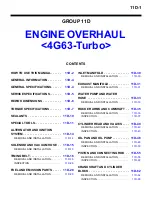
®
L o w D e l t a T S t i r l i n g E n g i n e
S E - 8 5 7 6 A
3
efficiency of an engine. No engine can exceed the Carnot
efficiency. (The second law of thermodynamics says you
can’t get out more than you put in; you can only break even.)
It takes good engineering and complex machines to achieve
a significant fraction of the Carnot efficiency. Real Stirling
engines can reach 50 percent of the maximum theoretical
value, which is a very high percentage.
Stirling Engines Today
The modern uses of Stirling engines are invisible to almost
everyone. There have been many research engines built in
recent years, but there are only three areas where Stirling
engines have made a dramatic impact. These are Stirling
engines in submarines, in cryocoolers, and in science class-
rooms.
Cryogenics is the science of things that are very cold, and
Stirling engines can be used to produce extremely cold tem-
peratures. It’s not obvious, but a Stirling engine is reversible.
If you warm one side and cool the other, you get mechanical
work out. However, if you mechanical work in, by connect-
ing an electric motor, for example, one side will get hot and
the other will get cold. In a correctly designed Stirling
engine, the cold side will get extremely cold. In fact, Stirling
engines used as cryocoolers have been made that will cool
below 10 kelvin (K). Micro-sized Stirling engines have been
produced in large numbers for cooling infrared chips down
to 80 K for use in night vision goggles and infrared cameras.
Since Stirling engines are so efficient, an obvious question
is: Why doesn’t my car have one?
Although a variety of prototype Stirling engine powered cars
have been developed, they have not gained popularity
because that have to warm up for 30 seconds to a minute
before they will move. Most consumers have not been will-
ing to wait that long to get started. The low gas prices of the
1980s and 1990s did not provide an economic incentive for
consumers to switch to Stirling engines, and automobile
companies have not had the incentive to research and
develop more saleable engine designs.
Stirling Engines in the Future
Future uses of Stirling engines could include applications in
the maritime and aviation industries. Stirling engines would
work exceptionally well for auxiliary power generators on
pleasure boats, where their silence and efficiency would be
value, and cooling water is plentiful. Some research has
already been done in this area: the French research subma-
rine “Saga” is Stirling engine powered. Stirling engines
would also work very well in airplanes where the air gets
cooler as the plane climbs to altitude. Stirling engines would
not lose as much power as they climb as conventional piston
engines or jet engines. Stirling engines would operate with
very low levels of vibration and noise.
Technical Support
For assistance with any PASCO product, contact PASCO at:
For more information about the Low Delta T Stirling Engine
and the latest revision of this Instruction Sheet, go to the
PASCO web site at www.pasco.com and enter SE-8576A in
the Search window.
Limited Warranty
For a description of the product warranty, see
the PASCO catalog.
Copyright
The PASCO scientific
012-06870B
Low Delta T Stirling Engine Instruction Sheet
is copy-
righted with all rights reserved. Permission is granted to non-profit
educational institutions for reproduction of any part of this manual,
providing the reproductions are used only in their laboratories and
classrooms, and are not sold for profit. Reproduction under any other
circumstances, without the written consent of PASCO scientific, is
prohibited.
Trademarks
PASCO and PASCO scientific are trade-
marks or registered trademarks of PASCO scientific, in the United
States and/or in other countries. All other brands, products, or ser-
vice names are or may be trademarks or service marks of, and are
used to identify, products or services of, their respective owners. For
more information visit www.pasco.com/legal.
Address:
PASCO scientific
10101 Foothills Blvd.
Roseville, CA 95747-7100
Phone:
+1 916 786 3800 (worldwide)
800-772-8700 (U.S.)
Web:
www.pasco.com
Email:





















